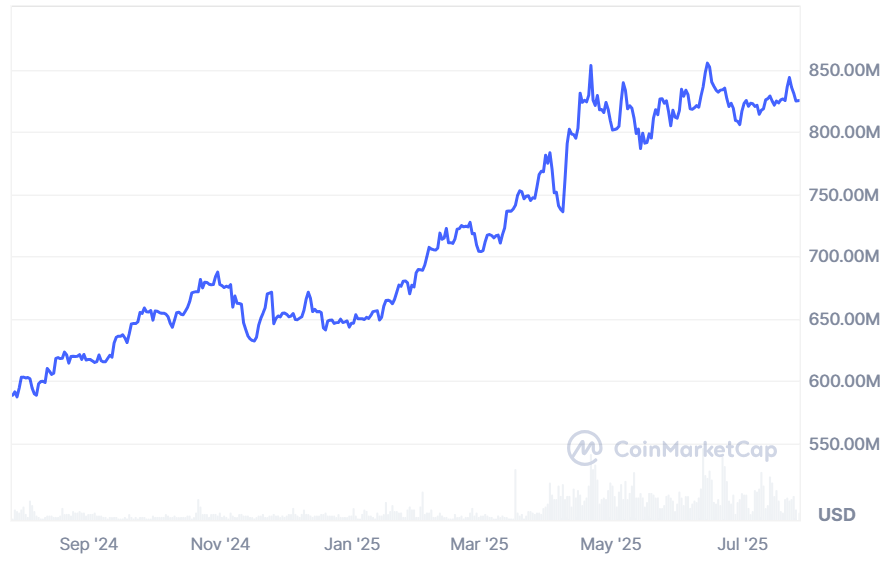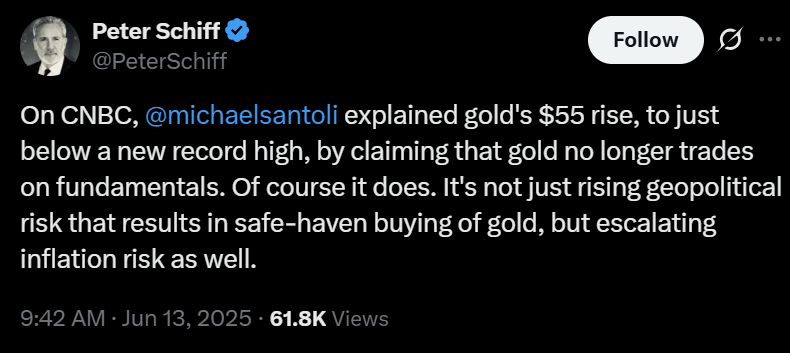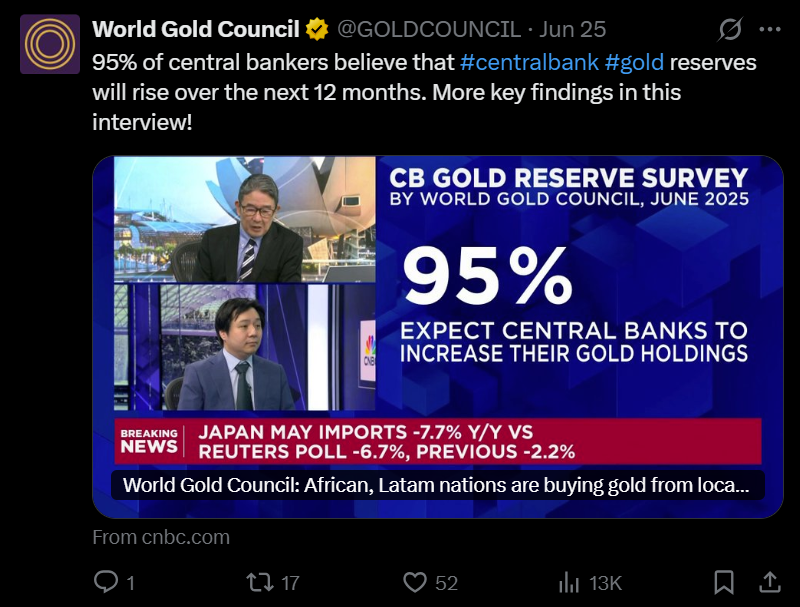Tether Gold (XAUt) is a digital token backed by physical gold, currently supported by 7.66 tons of bullion and valued over $800 million, mirroring record-high gold prices amid global economic uncertainty.
-
Tether Gold combines the stability of physical gold with blockchain technology, offering investors a portable and divisible asset.
-
Institutional and central bank demand for gold has surged, driving both bullion prices and XAUt’s market capitalization upward.
-
According to COINOTAG sources, XAUt’s price has increased by 40% over the past year, closely tracking spot gold performance.
Tether Gold (XAUt) surges with record gold prices, backed by 7.66 tons of bullion and $800M market cap. Explore the latest trends and investment insights today.
How Tether Gold (XAUt) Reflects Rising Gold Demand Amid Economic Turbulence
Tether Gold (XAUt) is a tokenized commodity that offers direct exposure to physical gold, currently backed by 7.66 tons of fine troy ounces, according to the latest attestation by BDO Italia. This reserve supports over 259,000 tokens, giving XAUt a market capitalization exceeding $800 million. The token’s price closely tracks physical gold, which trades just below $3,400 per troy ounce, combining gold’s traditional value with blockchain’s advantages such as portability and divisibility.
What Drives Institutional and Central Bank Interest in Gold?
Global central banks have accumulated over 1,000 metric tons of gold in 2024, marking a third consecutive year of significant stockpiling, as reported by the World Gold Council. This trend reflects rising geopolitical risks and currency instability. Christopher Gannatti, global head of research at WisdomTree, notes that central banks have reversed decades of selling gold, now aggressively rebuilding reserves. Institutional investors have also increased allocations to gold ETFs, with inflows reaching $38 billion in the first half of 2025, the largest in five years.

How Does Inflation Impact Gold and Tether Gold’s Appeal?
Persistent inflationary pressures, especially in the United States, have renewed interest in gold as a hedge. Economist Peter Schiff highlights that tariffs and rising production costs are expected to accelerate inflation in the latter half of 2025. This outlook has led to cautious monetary policies, with experts like Preston Caldwell from Morningstar delaying expectations for interest rate cuts. As inflation risks mount, gold’s role as a stable store of value strengthens, directly benefiting assets like Tether Gold.

What Are the Advantages of Holding Tether Gold (XAUt) Over Physical Bullion?
Tether Gold offers the security and intrinsic value of physical gold with enhanced liquidity and ease of transfer. Unlike traditional bullion, XAUt tokens are easily divisible and can be traded on multiple crypto exchanges, including Bybit, Bitfinex, BingX, KuCoin, and Maxbit in Thailand. This digital format enables investors to gain gold exposure without the logistical challenges of storing and transporting physical metal.
How Has XAUt Performed Compared to Spot Gold?
Over the past 12 months, XAUt’s price has increased approximately 40%, closely mirroring spot gold’s performance. This correlation underscores the token’s reliability as a digital proxy for gold, providing investors with a blockchain-based asset that reflects real-world bullion value.
| Asset | 12-Month Price Change | Market Capitalization |
|---|---|---|
| Tether Gold (XAUt) | +40% | Over $800 million |
| Spot Gold | +40% | — |
Frequently Asked Questions
What is Tether Gold (XAUt) and how does it work?
Tether Gold (XAUt) is a blockchain-based token backed by physical gold, allowing holders to own and trade gold digitally with the benefits of portability, divisibility, and redeemability.
Why is gold demand increasing among central banks and investors?
Gold demand is rising due to geopolitical tensions, inflation concerns, and economic uncertainty, making it a preferred safe-haven asset for preserving wealth.
Key Takeaways
- Tether Gold (XAUt) is backed by 7.66 tons of physical gold, providing a secure digital asset linked to bullion.
- Gold demand is surging due to geopolitical and inflationary pressures, driving institutional and central bank accumulation.
- XAUt offers blockchain advantages over physical gold, including ease of trading and divisibility.
Conclusion
Tether Gold (XAUt) effectively bridges traditional gold investment with blockchain technology, reflecting rising global demand amid economic uncertainty. As geopolitical risks and inflation concerns persist, XAUt stands as a compelling digital asset for investors seeking gold exposure with enhanced liquidity and security.
As gold hits record highs amid economic uncertainty, Tether Gold (XAUt) sees continued growth, mirroring institutional and central bank demand for the metal.
A volatile macroeconomic landscape has sparked a new gold rush among institutional investors and central banks, with gold bullion hitting record highs this year — a trend that has also extended to Tether’s gold-backed digital token.
By the end of the second quarter, Tether Gold (XAUt) — a tokenized commodity offering direct exposure to physical bullion — was backed by 7.66 tons of fine troy ounces of gold, according to the company’s latest attestation report, verified by BDO Italia.
This reserve supports over 259,000 XAUt tokens in circulation, giving the asset a total market capitalization exceeding $800 million.
The price of Tether Gold closely tracks the market value of physical gold, which is trading just below $3,400 per troy ounce. XAUt effectively brings gold onto the blockchain, combining the timeless appeal of the yellow metal with the portability, divisibility and redeemability features commonly associated with Bitcoin (BTC).
Over the past 12 months, XAUt’s price has surged by 40%, mirroring the performance of spot gold, according to Bloomberg data.

Tether Gold (XAUt) market cap growth. Source: CoinMarketCap
Tether Gold, which launched in January 2020, is available for trading on several major crypto exchanges, including Bybit, Bitfinex, BingX and KuCoin. The token recently expanded its presence to Thailand through the Maxbit cryptocurrency exchange.
As Cointelegraph reported, Tether’s liquidity network, USDT0, recently introduced an omnichain version of XAUt on The Open Network (TON).
Gold demand gains momentum amid macroeconomic and geopolitical turbulence
While crypto investors have long touted Bitcoin as “digital gold,” offering similar qualities to bullion with added portability and digital-native features, physical gold remains the ultimate safe-haven asset during times of uncertainty.
According to the World Gold Council (WGC), global central banks accumulated over 1,000 metric tons of bullion in 2024, marking the third consecutive year surpassing that milestone. The Council also noted that the vast majority of central bankers expect bullion reserves to continue rising over the next 12 months.

Source: World Gold Council
“This is not normal,” wrote Christopher Gannatti, global head of research at WisdomTree, commenting on the rapid pace of gold accumulation by monetary authorities. “For decades, central banks were net sellers of gold. Now they’re stockpiling it again.”
“In a world of rising geopolitical risk and currency weaponization, gold is one of the few assets that travels well across borders and regimes,” Gannatti added.
Institutional investors have followed suit, pouring billions into gold exchange-traded funds (ETFs) in the second half of 2024.
This momentum has carried into 2025, with the first half of the year witnessing the largest gold ETF inflows in five years, according to WGC data. Gold ETFs recorded $38 billion in inflows during the first six months, increasing collective holdings by 397.1 metric tons of physical bullion.
The surge in demand has been driven by escalating geopolitical and economic concerns, including US President Donald Trump’s trade war, which has amplified fears of economic instability and a potential recession.
Economist Peter Schiff has also highlighted persistent inflation risks as a key driver of gold’s appeal. Inflationary pressures have resurfaced in the United States, with the Federal Reserve expecting price increases to accelerate in the second half of the year as tariffs push costs higher for producers and consumers.

Source: Peter Schiff
This outlook has prompted a cautious stance on monetary policy. Morningstar’s senior US economist, Preston Caldwell, noted that he has “delayed expectations of rate cuts” in light of these inflationary trends.
Related: Despite record high, S&P 500 is down in Bitcoin terms
